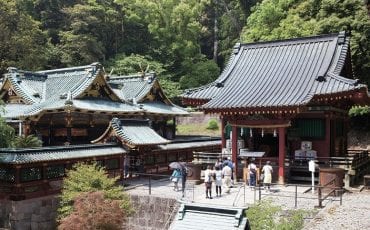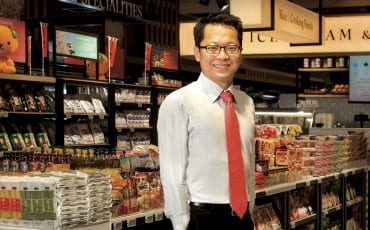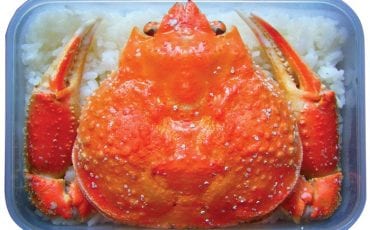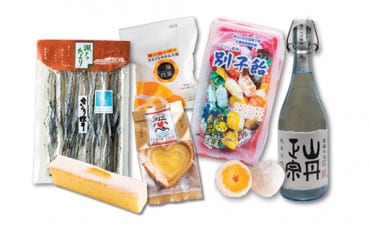- OISHII
- Articles
- Chefs Interview
- Oh My, Oden!
Articles
Chefs Interview
Oct 23, 2017
Oh My, Oden!
This autumn hit is so steeped in Japanese culture it’s even an emoji! We find out what makes traditional oden the love of a nation, and its many modern interpretations.
The next time you’re texting someone, scroll through the emojis on your smartphone. You’ll be able to spot this food item thanks to its distinctive shape: a skewer with a triangle, circle, and rectangle. Each one of these shapes symbolises the basic ingredients found in oden, a well-loved dish by the people of Japan.
While we can pinpoint when emojis began, the exact origins of oden are meanwhile shrouded in mystery. Some claim that the dish is a refined version of dengaku from the Muromachi Period (1338 – 1573). Back then, its earlier counterpart comprised of tofu and triangular konnyaku—a jelly-textured snack made from yam—served on a skewer, and topped with miso paste.
Today, the dish contains numerous ingredients, from circular satsuma-age (fried fish cake) to mochikin (mochi balls wrapped in a silky purse of beancurd skin). It is served in a bowl of dashi stock, and eaten with condiments like mustard and yuzu kosho, a tangy paste made from green peppers and yuzu peel.
Japanese children and adults consume oden during colder seasons like autumnand winter for its nourishing warmth and earthy flavours. Apart from it’s varied palate of textures and flavours, it’s popular precisely because you can choose your favourite ingredients as you please!
In our hunt for the best oden spots within Singapore’s city centre, we discover three chefs who share more about the various ingredients used in this traditional dish, and the various ways to appreciate it. Ranging from the traditional to innovative (does chilled oden tickle your fancy?), oden marks the spot for a filling meal loved by all.
Koki Miyoshi
Managing Director of Kamoshita
We begin our search for the island’s best odens in the sleek interiors of Kamoshita. Never one to shy from a challenge, Chef Miyoshi made the plunge into the F&B industry after university. In Japan, he chalked up 9 years of experience—both as an apprentice, and then manager of a restaurant in Yokohama. Soon after, he set his sights west and flew to London, where he served as a chef in the Japanese Embassy. In 2015, he moved to Singapore and worked at Izakaya before opening Kamoshita 1.5 years ago.
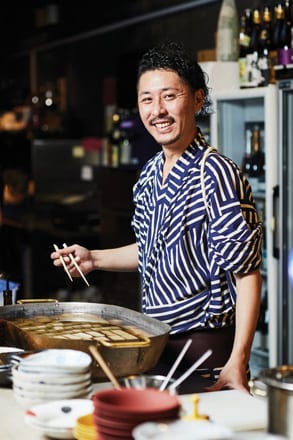 What is unique about the oden here?
What is unique about the oden here?
Most restaurants serve their oden with several ingredients in a single bowl. However, we plate ours in smaller dishes. Each dish contains a single ingredient steeped in our special stock—it doesn’t contain a single drop of soy sauce. This way, you get a purer concentration of our bonito, kombu, and saba mackerel-based stock that tastes light and flavourful. We also serve our odens in two ways: warm or chilled.
What inspired you to serve chilled oden?
Singapore has warm, humid weather, and most of its people enjoy colder treats to stave off the heat. So I thought chilled oden would be a nice adaptation to the tropical climate. At the same time, this is a great opportunity for people to better appreciate dashi and Japanese food culture in a modern yet sophisticated way.
Which ingredients suit chilled oden better?
We use whole tomatoes in our offerings. In particular, green, leafy vegetables like dou miao works better with chilled oden. When you stew vegetables, their colour tends to turn an unappetising shade of brown. On top of this, vegetables also leach out their nutritional value from being boiled. So, a chilled stock keeps its fresh flavours and presentational value intact.
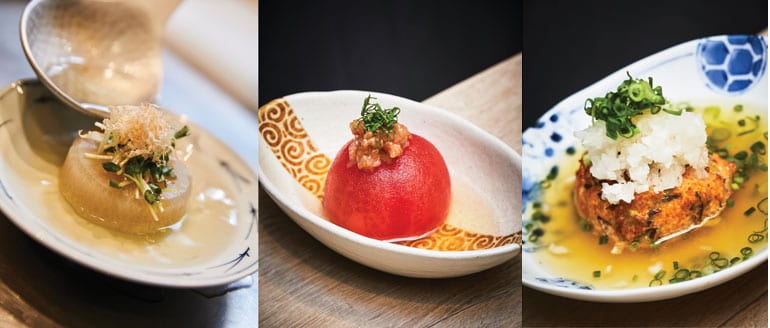
What are some important things a chef needs to note when making oden?
The hallmark of a good oden stock is its clarity. To achieve this, you need to prepare each ingredient well before placing it into the dashi. If not, your stock will become cloudy. For example, daikon must be boiled with rice to remove its bitterness, to keep its pale colour, and for better stock absorption.
Kamoshita
5 Neil Rd
Tel: 6221 3950
Zak Ngew
Chef at Sandaime Bunji
Savour Miyagi Prefecture’s best at this restaurant! Originally established in Ginza, Tokyo, the establishment was the first to serve fresh oden ingredients to lovers of the famed dish. This is the first of its outlets in Singapore from 6 years ago.
You can even sit seiza style at one of their tatami seats while enjoying mouthwatering East Japanese cuisine. For example, its famous ox tongue is a specialty of Sendai City, and its scrumptious oden bowls feature prized recipes from Shiogama City. Seafood lovers, rejoice—their oden makes use of oysters as a soup stock! We speak to one of their chefs on what makes oden here so special:
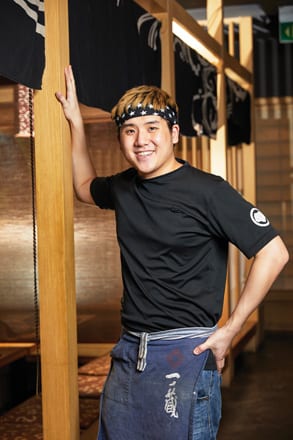 Is the oden here authentically Japanese?
Is the oden here authentically Japanese?
It is as authentic to the original Shiogama oden recipe as it can possibly get. If a Japanese were to walk in and taste our oden, they would immediately recognise its distinct flavour. We also have up to 14 different ingredients for customers to pair with our dashi stock, so you can enjoy an extra large meal!
Does oden have a single, original recipe?
There are many variations of oden, as each prefecture—or family for that matter—has a different way of preparing it. For example, oden in Shizuoka Prefecture has a dark stock, whereas light stocks are the modus operandi Kyoto Prefecture.
What are some Japanese ingredients that patrons should try here?
I recommend trying our sakana sugi. Unlike heavily processed foods, it contains whole parts of fish meat and soft bones all blended together. Its soft, fibrous texture is matched with a rich and briny flavour. Our succulent eggs are also another must-try—they are soft and supple on the inside. That’s why extra care is put into their preparation.
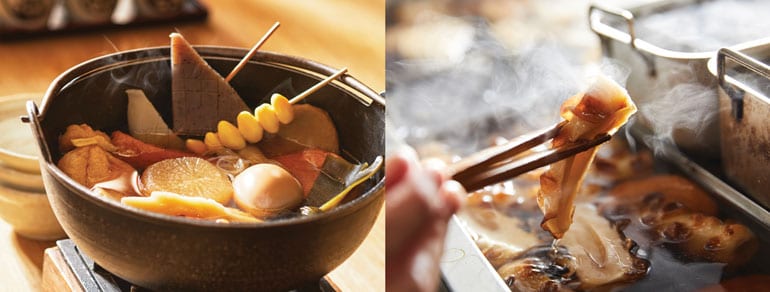
How do you achieve a premium taste for oden ingredients?
Each ingredient has a different rate of absorbency, so they need to stew for varying lengths of time to ensure a premium taste. Daikon takes slightly longer to absorb the stock, so it can’t simply be speedily heated up. It needs to be boiled for 2 hours first and then stewed with our oyster stock. Conversely, if you stew some ingredients like the flour-based chikuwabu for too long, it loses its taste and robust, rectangular shape.
Sandaime Bunji
#01-14/15 Millenia Walk, 9 Raffles Blvd.
Tel: 6333 1516
Junko Maruyama
Okami at Jun Oden & Sake Bar
After a day of hard work, wind down and relax at Jun Oden & Sake Bar. Open since Decemeber 2016, this hole-in-the-wall establishment is a respite from the bumbling Orchard Road crowds. Decked with antique Japanese paraphernalia, the bar transports you to the late Shōwa Period (1926 - 1989).
Prior to this place’s opening, Ms. Maruyama ran a 140-seater restaurant in Singapore for 10 years. Today, she runs the bar on her own as an okami, a proprietress, and makes comforting oden. The special part? Its stock is mixed with sake when served—yum!
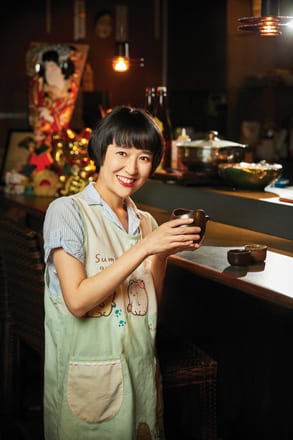 How do you prepare your oden stock?
How do you prepare your oden stock?
It’s common to use a seafood-based stock for oden. But apart from incorporating bonito, I also use chicken in my stock. To get a concentrated flavour, I boil the chicken for many hours. Everyday, I replenish the stock pot with water and a fresh batch of ingredients, so it never runs dry.
Tell us more about how you started serving sake mixed with oden stock.
I serve dashi stock in a cup, and mix in some sake. This creates a warm, nourishing broth that’s perfect for a cold day. However, it’s not a traditional recipe. Rather, I saw this method from a restaurant in downtown Tokyo—they added hot shochu to oden stock for a new take on oden. In my case, I simply replace shochu with sake.
What kind of sake mixes best with oden stock?
It’s best to use dry, strong sake. These are neutral selections that don’t clash with the stock, while giving an invigorating boost. In contrast, junmai ginjo and junmai daigingo tend to contain floral notes and have a sweet aftertaste. Mixing these with your oden stock will upset the balance of umami flavours.
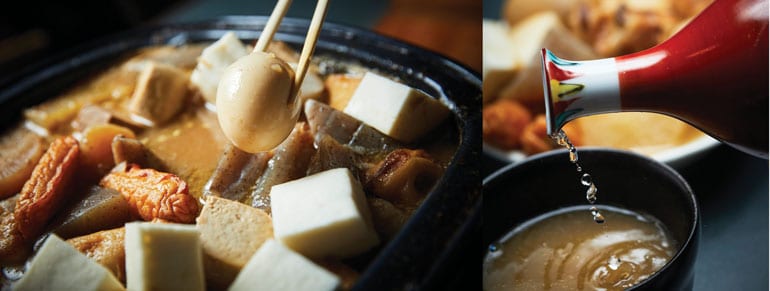
How do you get customers to continue visiting your bar?
Apart from serving good food and drink, I think it’s important to set a relaxing atmosphere. For instance, I do so by screening nostalgic performances of a bygone era on television. Some of the regulars here started out as strangers, but through mingling and enjoying each other’s company, they became friends. This creates a friendly community, and it makes me happy to see this.
Jun Oden & Sake Bar
#02-21 Orchard Plaza, 150 Orchard Road
Tel: 9625 1224





